RABINDRANATH AND ABANINDRANATH.*
IT was a happy thought to republish the two most popular collections of poems by the most famous of Bengali authors with illustrations by four leaders of the new school of Bengali painters. New Bengali art is beyond the experience of other parts of India, for, barely thirty years ago, art in Bengal was confined to crude woodcuts, grotesque clay idols clad in tinsel and brightly coloured tissue-paper, and the remarkable clay models of Nuddea. Yet even then, even before Mr. Havell gave a new and surprisingly sympathetic and indigenous impulse to the invention and expression of his Bengali pupils, those who best knew Bengal shrewdly guessed that the most literary and linguistically gifted race in India lacked rather opportunity and technique than capacity.and taste.
It may be objected that theirs is a hybrid art. But the same may be said of all the art, literary or other, that has survived into our time, save perhape the surprising drawings of the Cavemen. Rather should we rejoice that the contemporary renascence of art, letters, and learning in Bengal owes, and to some extent consciously and gratefully owes, its origins to Western example and encouragement. Rabindranath himself is Indian, but with a difference which is partly due to his personal genius, partly to his racial temperament as a Bengali, partly to his English educa- tion. Something of this mixed origin we may trace in the illus- trations ef his four artists, two of them members of his own remarkable family. The two most distinguished and original of these, Abanindranath Tagore and Nandalal Bose, hardly show to such advantage in the reduced reproductions of their work now published as in the charming colour-prints by Japanese engravers published some six years ago by the India Society. We find nothing quite so beautiful as the former's exquisite picture of " Sati," or the latter's moving and glowing representa- tion of Savitri interceding with the saffron-robed and gravely lovely Cod of Death.
We have, nevertheless, a singularly interesting interpreta- tion of the Bengali poet's imagination by gifted artists of his own race. To those who know and love the rustic scenery of Bengal, Abanindranath Tagore's depictions of dawn and dusk, an in the suggestive and subtle little picture entitled "The Bird of the Morning Sings," will rouse a not unhappy nostalgia. Those who know the poet's prose and verse best will remember that much of his work has been inspired by the picturesque variety of his native town of Calcutta, and will regret that the illustrators have made no attempt to represent its streets and alleys in sunshine and storm. Perhaps Bengali art has not yet awakened to the pictorial possibilities of the great cosmopolitan city, whose busy and variegated life plays so conspicuous a part in the contemporary novels of such men as Sarat Chandra Chatterjee and Charts Chandra Mukha*, to mention only two of a remarkable school of experimenters in fiction. But Bengali art thrives' and grows apace, and this little book has its historical value as marking a stage of singular interest, accomplishment, and unmistakable promise. Abanindranath Tagore's little ater.colour at p. 126 is delightful, and the piping cowherd lad recalls many pleasant passages in old poete in praise of the divine Covinda.
Altogether, a charming and welcome addition to the now familiar Gilanjaii and Fruit-Gathering.


































 Previous page
Previous page